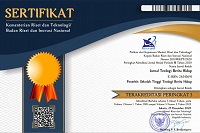Konsep Imam dan Jabatan Imam pada Masa Intertestamental
DOI:
https://doi.org/10.38189/jtbh.v3i1.50Abstract
ABSTRACT
The intertestamental period is a Protestant term, while the deuterocanonical period is a Catholic and Orthodox Christian term to refer to the time gap between the period covered by the Hebrew Bible or "Old Testament" and the period covered by the Christian "New Testament". Traditionally, this period is thought to cover about four hundred years, from the time of Malachi's ministry (420 BC) to the advent of John the Baptist in the early 1st century AD, a period that is almost the same as the Second Temple period (530 BC to 70 M). It is known by members of the Protestant community as "400 Silent Years" (400 Silent Years) because it is believed to be a time period in which God did not reveal anything new to His people.
However, it is undeniable that in the intertestamental times there are many parts of history that are sometimes questioned and are being sought for truth. Because after all, even though 400 years of God's silence did not speak to humans, the world's history continues. Although the context is mostly in the form of ruling kingdoms. And religious history also continues, with a tradition built. Among them about the journey of the concept of the priesthood in tradition in Israel as the concept of worship for the Jews. The question which is still being debated and becoming a conversation is First, what are the duties and responsibilities of the high priest during the intertestamental period? Second, are priesthood rules in the Torah still enforced during the intertestamental period, or are there changes and adjustments?
Through this paper, the author will give a little understanding of what happened during the intertestamental period in connection with the priestly ministry in Israel.
Â
ABSTRAK
Periode intertestamental (bahasa Inggris: Intertestamental period) merupakan suatu istilah Protestan, sedangkan periode deuterokanonikal (bahasa Inggris: deuterocanonical period) adalah istilah Katolik dan Kristen Ortodoks untuk menyebut kesenjangan waktu antara periode yang dicakup oleh Alkitab Ibrani atau "Perjanjian Lama" dan periode yang dicakup oleh "Perjanjian Baru" orang Kristen. Secara tradisional, periode ini dianggap mencakup kira-kira empat ratus tahun, sejak masa pelayanan Maleakhi (420 SM) sampai kepada munculnya Yohanes Pembaptis pada awal abad ke-1 Masehi, suatu periode yang hampir sama dengan periode Bait Suci Kedua (530 SM hingga 70 M). Dikenal oleh anggota komunitas Protestan sebagai "400 Tahun Sunyi" (400 Silent Years) karena diyakini merupakan kurun waktu di mana Allah tidak menyatakan apa-apa yang baru kepada umat-Nya.
Namun tidak bisa dipungkiri bahwa dimasa-masa intertestamental banyak sekali bagian-bagian sejarah yang terkadang banyak yang dipertanyakan dan sedang dicari kebenarannya. Sebab bagaimanapun juga meskipun 400 tahun masa Allah diam tidak berbicara kepada manusia, manusia sejarah dunia tetap berjalan. Meskipun konteksnya banyak berupa kerajaan-kerajaan yang berkuasa. Dan sejarah keagamaan juga tetap berjalan, dengan sebuah tradisi-tradisi yang dibangun. Diantaranya tentang pejalanan konsep keimaman dalam tradisi di Israel sebagai konsep penyembahan bagi orang-orang Yahudi. Pertanyaan yang masih menjadi perdebatan dan menjadi perbincangan adalah Pertama, bagaimanakah tugas dan tanggung jawab imam besar pada masa intertestamental? Kedua, apakah aturan keimaman dalam Taurat tetap ditegakkan pada masa intertestamental, ataukah ada perubahan dan penyesuaian?
Lewat makalah ini, penulis akan sedikit memberikan pemahaman tentang apa yang terjadi di masa intertestamental sehubungan dengan perjalanan pelayanan keimaman di Israel.
References
Adiprasetya, Joas. Mencari Dasar Bersama. Jakarta: BPK Gunung Mulia, 2009.
Berkhof, Louis. The History of Chirstian Doctrines. Michigan : Grand Rapids. 1981.
Enns, Paul. The Moody Handbook of Theology 2. Malang : SAAT, 2006.
Erickson, Millard J. Teologi Kristen. Jil. 2. Malang : Gandum Mas, 2003.
Evans, Gallian R., Alister E. McGrath dan Allan D. Galloway. The Science Of Theology Volume One. Michigan: Grand Rapids, 1986. [Editor: Paul Avis].
Ferguson, Sincalir B dan David F. Wright. New Dictionary of Theology. England : Intervarsity Press.
Grenz, Stanley J., dan Roger E. Oslon, 20TH Century Theology. God and the World in a Transitional Age, (Illinois. USA: InterVarsity Press, 1992).
Knitter, Paul F.. Pengantar Ke Dalam Teologi Agama-Agama. Yogyakarta: Kanisius, 2008.
Kreeft, Peter, dan Ronald K. Tacelli. Pedoman Apologetik Kristen Jilid 1. Bandung: Yayasan Kalam Hidup, 2006. Cetakan Kedua.
Lumintang, Stevry Indra. Teologi Abu-abu. Pluralisme Iman: Kristologi Abu-abu. Malang: Departemen Literatur YPPII, 2002. (dalam bentuk PDF).
Macleod, Donald. The Person Of Christ. Contours of Christian Theology. Illinois: InterVarsity Press, 1998.
Nash, Ronald H. Konflik Wawasan Dunia. Surabaya: Momentum, 2008.
Penyusun, Tim. Kamus Besar Bahasa Indonesia Edisi Ketiga. Jakarta: Balai Pustaka, 2002.
Pfeiffer, Charles F. Antara Perjanjian. Grand Rapids, Mich.: Baker Book House, 1959.
Ryrie, Charles C. Teologi Dasar. Jil. 1. Yogyakarta : Yayasan Andi. 1992.
The International Standard Bible Encyclopedia, Vol 1.
Thiesen, Henry C. Teologi Sistematika. Malang : Gandum Mas, 2003.
Wellem, F. D.. Riwayat Hidup Singkat Tokoh-tokoh dalam Sejarah Gereja. Jakarta: BPK Gunung Mulia, 2011.
Wilson, John E..Introduction to Modern Theology. Trajectories in the German Tradition. London: Westminster John Knox Press, 2007.


.jpg)







